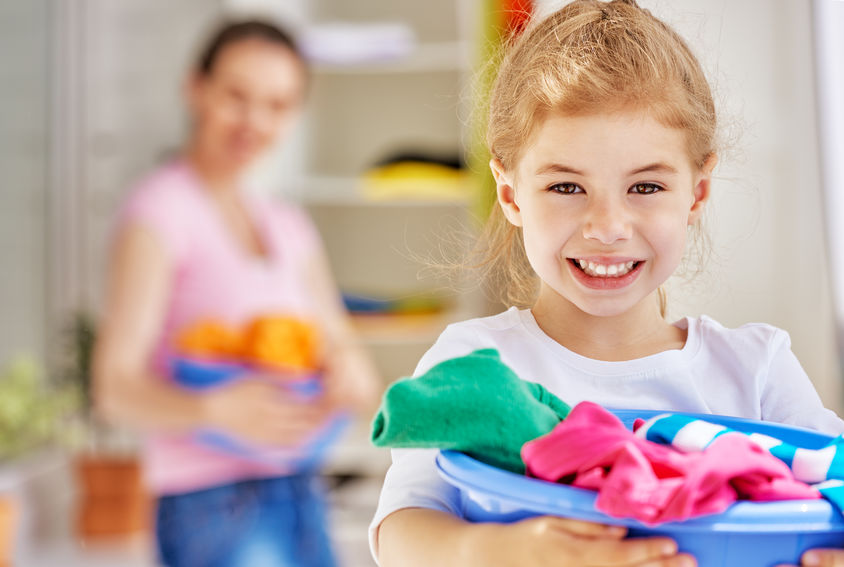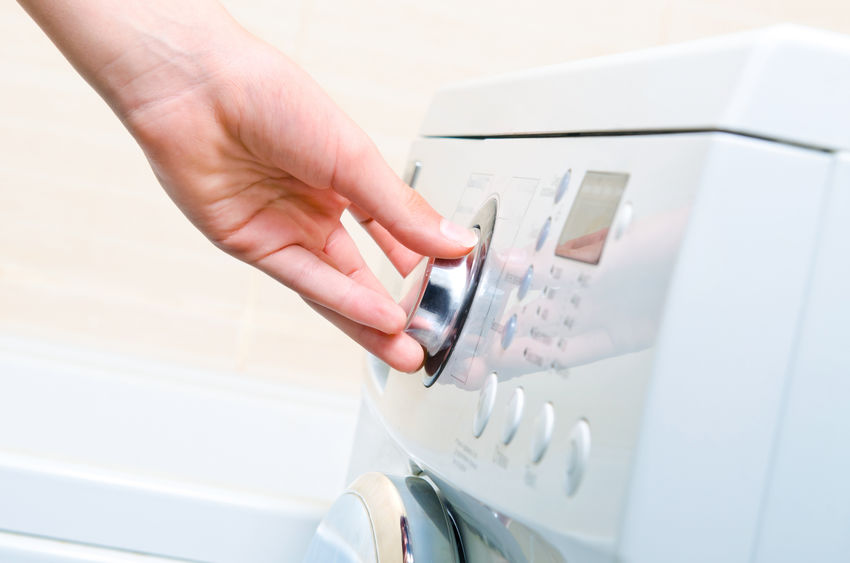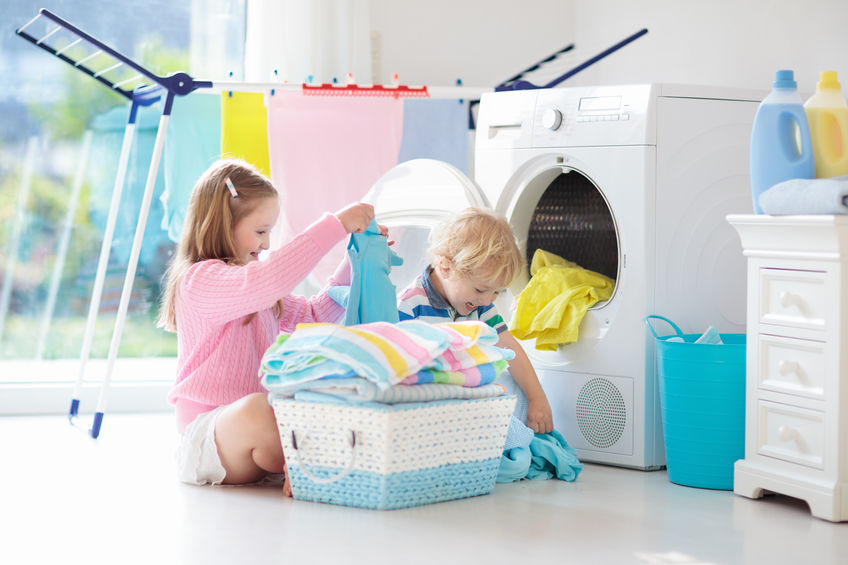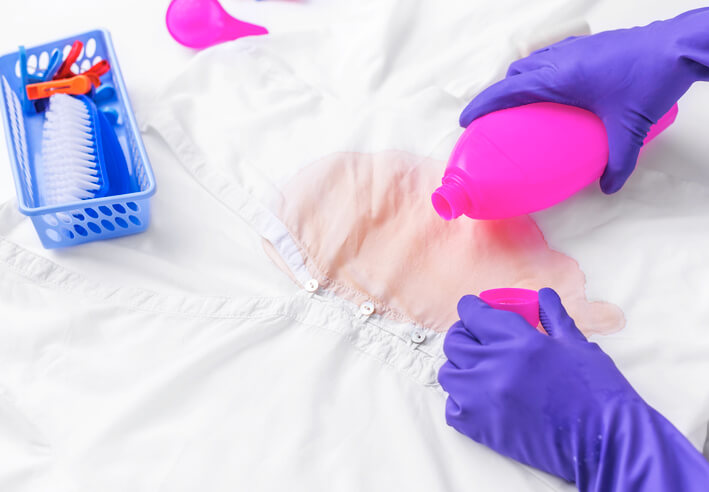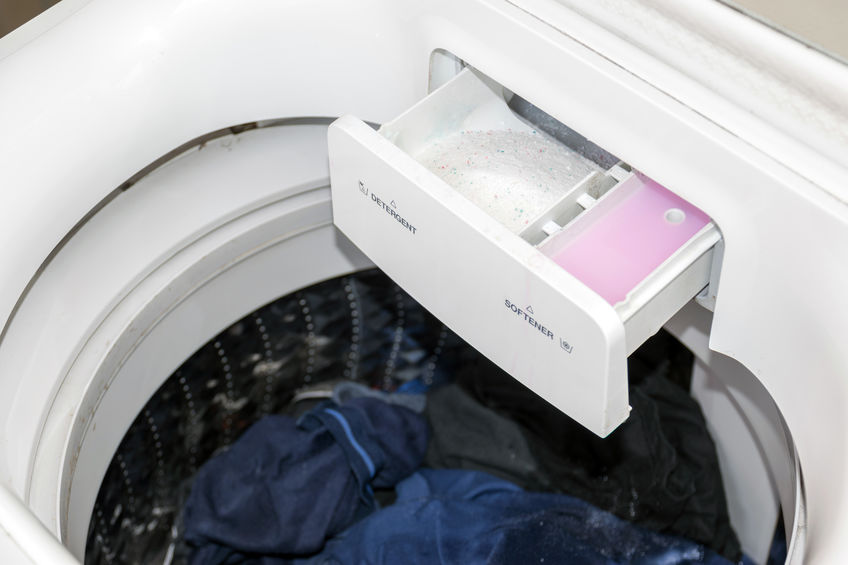- Clean Home
- Laundry Tips & Techniques
- Doing Laundry With Kids
Doing Laundry with Kids
When doing laundry with kids, you must start by reviewing the wash-day basics.These are the basic concepts any kid will need to succeed in the world of dirty laundry.
The entire laundry process can be distilled into three simple steps: getting the dirty clothes to the machine, washing and folding the clothes, and putting the clean clothes away.
It's a manageable process that you and your kids can easily handle together. Let's talk about each step in turn and get started.
Doing Laundry with Kids: Getting Dirty Clothes to the Machine
Of course, before any laundering can occur, you must remove the dirty clothes from the child, put them in the laundry basket or hamper, and finally, put them in the laundry room.
Here's how to make it easy for the entire family to get their clothes to the machine, regardless of the school-to-practice or gym-to-work rush they happen to be in.
One effective strategy is to strategically position laundry baskets. Provide baskets for each bathroom or bedroom for garments needing standard laundering, such as school uniforms and play clothes.
This approach can streamline the laundry process for the entire family.
Then, position a "special attention" or "stain" basket on the washing machine for clothes sporting visible drips, drops, or smudges of everything from finger paint to cross-pen leaks.
Less-visible everyday splotches usually come out well if you wash as directed with enzyme-containing laundry detergent and bleach if safe for the fabric. Last, place a "dry cleaning" basket in one of the bathrooms for items labeled "Dry Clean Only."
End the Search for Sock Mates
Here is my favorite pre-laundry trick for shaving time off the laundering process and removing the "Whose sock is it, anyway?" question when doing laundry with kids.
A few months ago, frustrated to the breaking point by the troops' complaints about getting mismatched or someone else's socks, I instituted the "Clipped Sock Rule."
If dirty socks aren't clipped with their mates, they go out of the dryer directly into the "homeless sock" basket. No whining allowed.
Before putting their socks into the laundry basket, each family member clips each pair of socks with a clothespin.
To make identifying the clipped sock pairs easy, I picked up an industrial-size clothespin bag, the kind that comes with four colors of clothespins.
Then I assigned each of us a color: daughter Lyndsay is blue, I"m yellow, and Chris Jr. is red. I'm happy to report that the socks stay clipped together through the laundry process.
What a difference a clip makes! The tedious matching of socks is history. I have no more complaints about missing socks or misdelivered pairs.
Doing Laundry With Kids and Getting Kids' Clothing Favorites Washed
Just about every kid has a favorite item she's always wearing, making laundering it regularly tricky.
Laundry with Kids: Hoop Dreams
Installing a basketball hoop over the hamper really works up enthusiasm for neatness. Be sure, however, that you have adequately covered Laundry 101: If it's not dirty and it doesn't smell, don't put it in the hamper) so that the hamper is not full of clean clothes.
If this describes a child in your home, you may want to forgo the power struggles and instead go back to the store where you purchased the item to get a second item, just like the first.
Try reasoning (or mild threats) with older kids. Tell your daughter that if a said item doesn't make it to the basket on laundry day, it will be out of commission for an entire week.
Or, you can get tough and tell your son that he can only wear said item 'X' days a week. More, and it disappears. This is an excellent time to explain the importance of washing clothes to keep them looking (and smelling) fresh. We are trying to teach good habits while doing laundry with kids.
Whatever you choose, choose something. Continually fighting and begging a kid to hand his treasured article over so you can wash it isn't doing either of you any good.
He's learning that he won't have to do something if he resists strongly enough. Even something good for his health. And that's not the message you meant to send.
Washing and Folding Clothes
Now, the clothes are coming off bodies and into baskets as directed (not onto the floor). This is good. But someone needs to run the machine.
And it can't always be you. This is not so good, especially if your family has gotten used to your being the resident laundress. If you have older kids, they can alternate doing laundry for the family.
You're stuck with the job if you don't have older kids. If you only have older kids, everyone in the house could do his or their laundry. What a concept!
The problem with this solution is that you'll have more small loads. The benefit of this solution is that you'll teach your kids responsibility while ditching some of your own. (In a healthy way for your kids, of course.)
14 Steps to Clean Clothes
Here is my simple 14-step approach to doing laundry with kids. Share it with your kids.
1. Treat spills fast. Immediately rinse or blot away spills on clothes to prevent stains from setting. (Dampen a clean white rag and dab at the stain. You'll see color transfer to the rag. That's how you'll know it's working.) Then wash the clothes as soon as you can.
Have kids red-flag stains and spots by clipping a clothespin to a chocolate smudge or tying a grass-stained jeans leg in a loose knot before dumping the garment into the clothes hamper.
2. Before washing stained garments, pretreat or presoak the spot according to the product directions.
3. Sort laundry by color, amount of soil, wash cycle needed, and water temperature required. (Read fabric care labels before you wash. Your clothes will last longer if you care for them as recommended.)
Also, sort lint givers, like towels, from lint takers, like corduroy - separate delicates from heavy clothes such as jeans. One more thing: Don't wash heavily soiled clothes such as gardening duds with your fine linens.
Also, you may want to run an empty load (with bleach) after washing sneakers or the dog's bed to decontaminate the machine. Learn to disinfect the washer here.
4. To keep snags and lint to a minimum, zip zippers, button buttons, brush away lint, and empty pockets before tossing clothes into the hamper. Melted crayons overlooked during this process are no fun to tackle. (See the laundry stain removal guide.)
Hard objects like pins and yo-yos can bang around in the washer and tear your clothes.
5. Select the water temperature. Generally, use hot for whites or very dirty or greasy clothes, warm for most loads, and cold for delicate or dark or bright colors that could run.
Always select "cold" for the rinse-water temperature. It saves energy and is just as effective.
6. Turn the machine on to fill the tub with water.
7. Add detergent and laundry boosters, such as color-safe bleach, bleach, or fabric softener (for fluffier clothes), according to the package directions. If you don't have a special dispenser for the boosters, pour them into the wash water once the machine is filled. If your clothing is heavily soiled, if you're washing a large load or using cold water, add extra detergent.
8. Dump in the clothes. If you have to stuff them in, you've got too much stuff. The machine should be no more than about two-thirds full. The clothes need to tumble around to get clean. Unsure? Watch for rollover of small items such as socks when the machine is washing. They should sink and reappear later if they don't; they're too cramped for their own good. And yours.
9. After the clothes have been washed, check wet garments for remaining stains, and re-treat as needed before drying. If you dry stained clothes in the dryer, the heat will set stains.
10. Once the clothes are clean, you can just put the load from the washer into the dryer. Remember, though, that it's best to dry loads of clothes similar in fiber content and weight.
Heavier items, such as towels and sweatshirts, require more heat and time in the dryer than lighter clothes, such as gym shorts and swimsuits. Dry only full loads.
Tumbling a handful of garments prolongs the drying time by reducing the tumbling. Don't overstuff the dryer, either. Overloading causes wrinkles and increases drying time, too.
11. Set the heat and time for the most delicate item in the load. Don't use a high or regular setting for all clothes. Read the label. Fibers that don't absorb lots of water, such as microfibers, nylon, and acrylic, dry faster and need a lower temperature setting than other fabrics.
Laundry with Kids: Jelly Rolling
Teach your youngest child still developing her coordination skills to "jelly roll" rather than fold her clothes. Rolling is a simple skill that kids ages 3 to 6 can manage on their own. Now even the youngest family member can put her clothes away and keep them tidy. By age 6, they're ready for the fold-and-go lesson.
12. Keep your eye on the drying time. Drying a load for too long can cause shrinkage and buildup of static electricity. Over-drying can ruin clothes, and it also wastes energy. (And we know how Dad hates that.) Leave clothes in the dryer just long enough to remove wrinkles and moisture. Some fabrics, such as Spandex and linen, will be damaged or shrink when dried with too much heat.
13. Fold clothes right away. The longer they sit in the dryer, the more wrinkled they become.
14. Clean the lint screen. A clogged lint screen can make dryers run for a long time. That wastes energy and money and causes wear and tear on your favorite clothes. Plus, it's a fire hazard.
When doing laundry with kids, you may need to show them how to do it several times—and then supervise them doing it several more times—before letting them do it alone.
Doing Laundry with Kids: Getting Clean Clothes Put Away
So far, so good. You've set up your home with laundry baskets in logical places. The family is dumping dirty duds where they belong.
Everyone takes turns bringing down the laundry baskets, running the machine, and folding the clothes.
But who will wave the wand to put the clothes back into their appointed drawers and closets? If you're fresh out of fairies, here are tips for helping clean clothes get put away.
Make each family member responsible. Each person fetches their laundry basket and puts his or her clothes away. A clean house rule to consider: Any baskets left unclaimed for more than 24 hours (without a school or sleepover excuse) will be removed from sight for one week (into the garage or a closet.)
Once your daughter has to live without her favorite jeans or your son has to go to practice without his uniform, the problem is unlikely to arise again anytime soon.
Make it easy. To simplify the process, make emptying the dryer, folding, and sorting clothes by room a weekly chore for one child.
The sorter is responsible for looking out for tears or missing buttons and placing those garments in a special mending basket.
Those with large families (like ours) may have several adults doing the laundry, at least when the children are very young. The solution?
I mark the labels on kids' clothing with a permanent clothing marker with dots. You get the picture: one dot for the oldest, two for the second child, three for the third child ... you get the picture.
Then, whenever a question arises about ownership, it's merely connect-the-dots-to-the-kids time.
A change of ownership due to growth spurts poses no problem; add a dot. (Older children rarely shrink, so you'll not have to worry about erasing dots.)
Troubleshooting Laundry With Kids
Be cautious as you go forth doing laundry with kids. Mixing water, soap, dirt, and kids can be a recipe for disaster. Here are some solutions to kids' common laundry problems:
Sweater shrinking. To unshrink a sweater, soak it in a sinkful of warm water and two tablespoons of baby shampoo, which relaxes natural fibers such as wool, for 15 minutes. Remove the sweater from the water and roll it in a towel to reduce moisture.
Pin the sweater to a large corkboard and stretch it to size. Return every few hours to restretch and repin the sweater until dry.
Graying or yellowing of fabrics. If clothes come out of the washer gray or yellow, rewash them before they dry using more detergent.
Color bleeding. Guess they forgot to sort correctly. But all is not lost, especially if the overly colored shirt or pants aren't tossed in the dryer.
Wash again in the hottest water safe for the fabric, as many times as necessary, to rinse out the transferred color. I know about this one. It's a challenge I've successfully tackled in my own home.
Fabric pilling. Many synthetic clothes shed tiny fibers that ball up and cling to the garments. Remove these pills with a fuzz-removing device, such as a sweater shaver.
Remove these pills with a fuzz-removing device, like this one from $13 battery operated sweater defuzzer by BEAUTURAL.Some clothing manufacturers suggest washing clothes inside out because it limits abrasion on the "good" side of the fabric, reduces pilling, and extends the life of fabrics such as corduroy.
Use this strategy to keep school names on uniforms crisp and sharp while doing laundry with kids.
- Clean Home
- Laundry Tips & Techniques
- Doing Laundry With Kids
